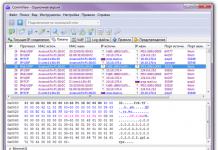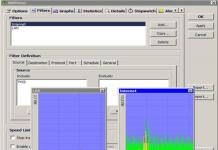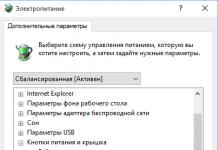The MS Excel program is designed to store data and perform calculations on it. One frequently used action is multiplying numbers. It is used to calculate statistics, find results, and in many other cases. In this article we will learn how to multiply in Excel.
The simplest option is to find the product of predetermined numbers. To perform this operation, use the multiplication command, which has the form of an asterisk - “*”. In order for Excel to perform an arithmetic operation, and not just write information into a cell as text, an equal sign - “=” is written before the product of numbers.
The snapshot shows two random numbers 12 and 28. Please note that cell C5 simply contains the text 12*28, which is displayed as such. In cell C4, we placed the “=” sign in front of the operation, and the program calculated the product. In this way, two or more numbers, both integers and fractions, are multiplied.
It is not possible to multiply numbers in the program very often. Much more common are tasks where it is necessary to calculate the product of the contents of cells or multiply the data in a cell by a number. Let's see how to multiply a number by a field value in Excel.
A young man pays for English language courses. The monthly cost of training is 6800 rubles. We want to know how much it will cost him to study for six months. We write down the cost of classes per month in the first cell, and in the adjacent field we get the result of multiplying it by the number 6.
To use a value from a cell in a formula, provide a link to it. In the example, the number is in field A2, so we write it in the operation.

Let us now assume that if you pay for courses in advance for a certain period, the amount is less than if you pay monthly. Let's calculate how much tuition will cost per year using different payment methods. The cost of the courses per month is 8200 rubles. If you pay for 3 months at once, the cost will be 23,100 rubles, which you will have to pay 4 times a year. Accordingly, if you transfer money for training twice a year, each time the amount will be equal to 42,300 rubles, and the one-time fee for the year in advance is 73,800 rubles.
Let's record this information in a table and calculate the amounts for each type of payment. Now the formula will contain references to two cells, one of which indicates the payment amount for the period, and the other - the number of such periods in the year. In order not to write a formula for each of the lines, format the information as a table, then in the calculation column, when you enter only the first formula, the program will enter the rest automatically.

Using Functions
Another option for multiplying numbers or values in cells in Excel is to use the PRODUCT function. If you need to multiply a large amount of data or entire ranges of cells, this function is more efficient than the arithmetic operation. Her call is written like this:
PRODUCT(number1;[number2];…),
where multipliers can be either values or ranges of fields.
The PRODUCT(A1:A6) function will multiply all the values in cells A1 - A6, and the result will be the same as if we wrote the formula A1*A2*A3*A4*A5*A6.

It should be remembered that the function only performs actions on numbers. If there are text values or empty cells in the specified range, the formula will ignore them.
Another way, like 2007 and later, is to paste specially the copied cells. The travel company has a 9% markup on hotel prices. To calculate the cost of selling rooms, we will use the specified method.
Let's copy the purchase prices into the adjacent column, where we will calculate the cost with a markup. We will enter the markup percentage itself - 1.09 - into an arbitrary cell. Now copy the cell with the markup percentage, select the range in which you want to get the works, and select the “Paste Special” menu item. It's in the list of Paste commands on the Clipboard toolbar on the Home tab.
In the settings window, select “multiply” and click “OK”.

We hope this article will help you in the future to easily multiply data in MS Excel and thereby make your work more efficient.
The MS Excel program is a spreadsheet processor designed for working with tabular data in electronic form, sorting, optimizing, statistically processing, and constructing charts. In MS Excel, for example, you can perform financial and accounting calculations, keep records of material assets, and prepare diagrams for presentations. An MS Excel file is called a workbook. It is convenient to perform calculations in a MS Excel workbook. Data from table cells can be added, multiplied, divided, and built-in Excel functions can be applied to the data. The rows in an Excel workbook sheet are numbered, and the columns are designated by letters of the Latin alphabet.
The cell containing the data is at the intersection of a row and a column and may have an address, for example N5, where N is the column designation and 5 is the row number. How to multiply data from one cell by data from another in Excel? Select the cell where the formula will be located. Any formula begins with an equal sign. After the equal sign there should be a reference to the cell (cell address), the data of which is a multiplier. You can write the cell address manually, or you can simply click on the cell and its address will appear in the formula. Then type the multiply sign (in Excel this is *) and the address of the second multiplier cell. For example, the formula might look like this: =B3*D3. There can be more than two factors: =B3*D3*F3*H3.
The example above uses relative cell addresses. When you copy a formula to another cell, the relative addresses also change accordingly. How to multiply data in Excel if it is necessary that when copying a formula, the addresses of the cells in it remain unchanged? In this case, you must use absolute cell addresses. The absolute cell address is obtained from the relative one by adding a $ sign before the column designation and before the row number. For example, $N$5 is an absolute address. No matter where you copy a formula of the form =$B$3*$D$3, it will remain unchanged. Mixed cell addresses contain either an absolute row and a relative column, or an absolute column and a relative row. For example, N$5 or $N5.
Using built-in functions, you can also implement multiplication in Excel. Call the function wizard with the fx button from the toolbar or from the Insert => Function menu. Select the “Mathematical” function category. To multiply, you need to select the “PRODUCT” function. Here, in the function wizard window, you can view help for the selected function. The PRODUCT multiplication function can have two or more arguments. Following the step-by-step instructions of the function wizard, perform multiplication. The formula is displayed in the formula bar and can be adjusted if necessary. To adjust the formula directly in a cell, double-click the left mouse button on the cell with the formula.
By default, the workbook sheet displays values. The excel spreadsheet editor also allows you to display formulas instead of values. In order to see the formulas in the workbook sheet, select Tools => Options from the menu. In the “Options” window that opens, on the “View” tab, in the “Window Options” group, put a check mark in the “formulas” field. The formula display mode is convenient to use when editing and checking calculations. To return the display of values to the workbook sheet, the check mark in the “formulas” field must be removed.
Adding, subtracting, dividing, multiplying numbers - all these arithmetic operations can be performed in Excel. In formulas you can use not only cell addresses, but also just numbers: =5+3*9. The order of operations can be changed if necessary using parentheses. For example, =5+3*9 - multiplication is performed first, and then addition. Calculation result: 32. A formula of the form =(5+3)*9 will display the result 72 in the cell, since the addition (5+3) was performed first, and then the multiplication 8*9. Excel displays the sum of the values of the selected cells at the bottom right in the status bar. Instead of the sum, you can set to display other values. The choice is made in the context menu of the status bar.
Excel is an indispensable program for working with digital data. It has a variety of capabilities. In this article we will take a closer look at how to multiply in Excel.
Multiplying numbers in Excel: options
- Multiplying numbers in one cell. To do this, simply multiply the required numbers in the cell using the multiply icon (*). For example, =3*5, the cell will display the value 15.
- Multiplying a range of numbers by a certain number. You may have a question about how to multiply a column in excel. For example, you need to enlarge each cell of a column by 3 times. To do this, you will need to multiply each cell by 3, how can you do this quickly? The answer is simple - copy the cell with the number 3 and perform the following operation: select the required column and call the menu by right-clicking. In this menu, select “Paste Special”, and in the window that appears, select insert formulas, operation - multiply.
- Multiplying numbers in different cells. In this case, you can use the “PRODUCT” function, or simply use the multiplication sign. When using the multiplication sign, the writing of the formula differs from the first case only in the use of cell names instead of numbers, for example, =C6*D6. When using the function, multipliers must be written using:
- comma (if you are multiplying individual cells), example: =PRODUCT(B2,B4,B6,2)
- colon (if you are multiplying a range of numbers), example: =PRODUCT(A2:A4)
In this case, you don’t have to write the names of the cells, but simply select the cell using the cursor; in addition, the multiplier can be not only a cell, but also a number.
You learned about how to multiply in excel. Study the program and it will make your calculations easier.
The powerful Microsoft Excel spreadsheet processor will easily multiply any of your numbers and ranges. When can it really be useful in this regard? There are many options:
- I don't have a calculator at hand.
- Large ranges of numbers are multiplied, and you need to see which numbers are involved, and perhaps replace some of them (in a regular calculator without a line saving function, you will have to start the calculation again).
- Multiplication is only part of a complex formula.
As you can see, multiplication in Excel is not a superfluous thing at all. Almost no formula can do without the multiplication operation.
Multiplication options in Excel
Excel allows you to multiply by each other:
- Specific numbers (positive, negative, integers, fractions).
- Numbers from the specified cells.
- Number ranges.
- Boolean values
How is multiplication performed? The multiplication formula in Excel begins with an equal sign (=). As in any formula, numbers (or links to cells containing them) are indicated one after another, connected by an asterisk (*). This formula will look like this: “=0.22*- 16” (when specific numbers are multiplied), or “=G I5” (when cell references are specified as arguments). This is the first multiplication option.
The multiplication formula in Excel can be written using the built-in PRODUCT function:
The advantage of using this particular function to perform multiplication in Excel is the ability to multiply not only numbers, but also ranges by each other.
Let's move on to consider specific examples.
Multiplying with an asterisk
Try the following examples on an Excel worksheet:
Value 1 | Value 2 | Formula | Result |
|
With their help, you will see that multiplying in Excel is very simple. Note that the result of multiplying Boolean values is 0 (FALSE) or 1 (TRUE). 
The only drawback of this multiplication method is that it cannot accept a range of numbers as an argument. Surely the maximum that any user can handle will be determined somewhere at the end of the second ten numbers or cells, sorted through in order and alternating with asterisks.
The only way to get around this drawback is to use the PRODUCT function.
Multiplying with the PRODUCT function
Let's look at how to do multiplication in Excel using the built-in function.
In the Excel workbook, create a similar table and check the examples using it. Enter multiple values in one column, and enter multiple values in another column. Try applying the PRODUCT function to your ranges, as well as manually multiplying using the asterisk sign.
Value range 1 | Value range 2 | Result | Formula |
|
PRODUCT(H12:H16;I12:I16) |
||||
PRODUCT(H12:I16) |
||||
H12*H13*H1 H1 H16*I12*I13*I1 I1 I16 |
||||
The “Formula” column of this table clearly shows that if the ranges of values are adjacent, then they can be used as one range. And also from the table you can see that the “PRODUCT” function multiplied all the numbers in the specified ranges, and the result was similar to what would happen if we manually multiplied the values from these cells one by one. As you can see, multiplication in Excel is not difficult at all.
Interesting fact! Try now to remove one value from any cell included in the range, let the cell become completely empty. You will see that when you do this, the PRODUCT function has performed the calculation by simply omitting the empty cell. But the result of “manual” multiplication turned to zero. This is another clear advantage of the built-in function over the asterisk multiplication option - it does not treat empty cells as zero, it simply leaves them out of the calculation. 
There are situations when calculations are carried out on several worksheets in a book, and a formula is entered into the final sheet, including the product of values from other sheets. If at least one of them is empty, a simple multiplication with an asterisk will turn all your results to zero.
From this we can conclude that when conducting complex calculations on several sheets, it is better to use the “PRODUCT” function as a priority. 
Multiplication table
Let's finally look at how to create a multiplication table in Excel. It's not difficult at all.
In the tradition of standard multiplication tables, let's enter one set of numbers in a column and another in a row. To be able to copy formulas, you must use mixed references - fix the number of the column with vertically located data and the row with horizontally located data using the dollar sign ($): “=$A2*B$1”.
The Microsoft Excel table editor has a very wide range of capabilities for solving problems of varying complexity in various fields of activity. This is why Excel has become so popular among users around the world. One of the basic skills of working with the program is to carry out simple calculations and mathematical operations. In this article, we will look in detail at how to perform addition, subtraction, multiplication and division in Excel. Let's get started! Go!
Mathematical operations are performed without using a calculator
All calculations in Excel are based on the construction of simple formulas with which the program will perform calculations. First you need to create a table with the values. Please note that each table cell has its own address, which is determined by a letter and a number. Each letter corresponds to a column, and each number corresponds to a row.
Let's start with the simplest operations - addition and subtraction. To add numbers, you can use the so-called “AutoSum” function. It is convenient to use in cases where you need to calculate the sum of numbers that are in a row in one row, column, or in the area you have selected. To use this tool, go to the "Formulas" tab. There you will find the “AutoSum” button. Having selected the section of the table with the values that need to be added, click on the “AutoSum” button. After this, a separate cell will appear containing the result of the calculation. This was the first approach.

The second approach is that the calculation formula is entered manually. Let's say you are faced with the task of calculating the sum of numbers scattered across a table. To do this, make active (click on it with the left mouse button) the cell in which you want to place the calculation result. Then put the “=” sign and, in turn, enter the address of each cell whose contents need to be summed, not forgetting to put the “+” sign between them. For example, you should get: “=A1+B7+C2+B3+E5”. After the address of the last cell is entered, press “Enter” on the keyboard and you will receive the sum of all marked numbers. It is not necessary to enter each address manually. Just click on a specific cell and its address will immediately be displayed in the formula field, put “+” after it and move on to the next one.

There is another approach - using the Paste Special function. This method is convenient because it allows you to summarize data from several separate tables, provided that all their columns are the same. First, create a pivot table into which you will paste the copied data. Select the numbers in one table and paste them into the summary table, then do the same with the values in the second table, only this time right-click on the cell and select “Paste Special.” In the window that opens, in the “Insert” section, check “Values”, and in the “Operation” section, select add. As a result, all data will be summed up.

Subtraction in Excel is performed in the same way as addition. You will need to enter a formula, indicating the required cells, only instead of the “+” sign, “-” is placed between the addresses.
To multiply numbers in Excel, write a formula, marking the required data and putting an “*” between them. The formula will look like this: “=A3*A7*B2”.

Division is done in the same way, only the “/” sign is used. You can also perform several arithmetic operations at once. Formulas are built according to mathematical rules. For example: "=(B2-B4)*E8/(A1+D1)*D4". The formula you construct can be of any complexity; the main thing is not to forget the basic mathematical rules so that the calculation is performed correctly.

Having mastered the skills of simple arithmetic calculations in Microsoft Excel, you can already simplify the process of solving some problems and save time. Excel allows you to solve complex equations, perform engineering and statistical analysis. Gradually mastering the basic functions and tools of the program, you will learn to perform more and more operations in the Excel editor. Write in the comments whether the article helped you deal with your questions and share your experience with other users.


























